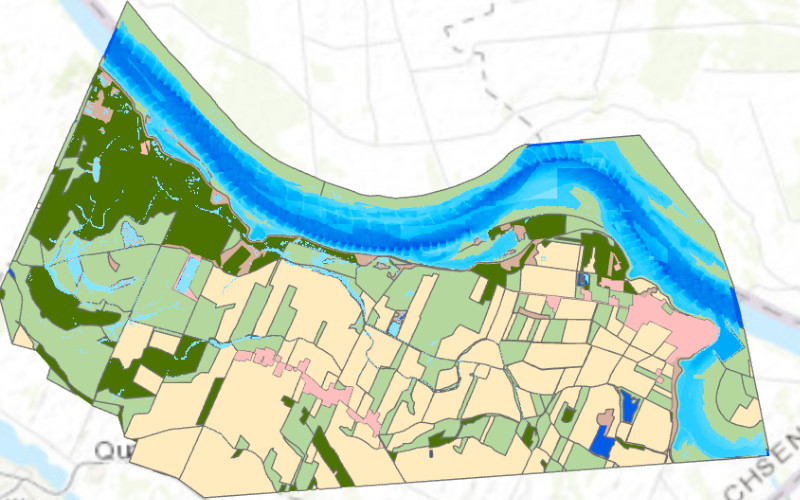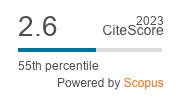Modelling flood regulation ecosystem services dynamics based on climate and land use information
DOI:
https://doi.org/10.3097/LO.202188Keywords:
MAES, Indicator, HEC-RAS, Scenarios, Nature-based SolutionsAbstract
The concept of ecosystem service (ES) identifies benefits that people obtain from ecosystems with contributions to human well-being. One important ES under external pressure is “flood regulation” that describes an ecosystem’s capacity to reduce flood hazards.
Several related studies estimate current flood regulation ES. However, regional climate projections indicate a shift in precipitation patterns. Therefore, Climate and land use changes make it necessary to assess future supply in order to test functionality and adaptation measures. This study focuses on surface retention ES. We used two methods to show the relevance of different landscape scenarios and climate information for flood regulation ES supply: 1) hydraulic simulations with the model HEC-RAS 2) the flood retention capacity indicator suggested by the German MAES-Working group. We simulated two events: the historic flood of 2013 and future hypothetically 10% higher water levels. Furthermore, three land use change scenarios were evaluated.
The model results indicate water accumulation by vegetation. Higher water levels of future climate scenarios lead to an increase in flooded areas and higher water volumes. To evaluate flood regulation capacities, an approach solely based on 2D retention areas, such as the MAES-indicator, is not sufficient. Modelling approaches deliver the opportunity for future scenario simulations.
References
AdV (Arbeitsgemeinschaft der Vermessungsverwaltungen der Länder der Bundesrepublik Deutschland) 2018. Dokumentation zur Modellierung der Geoinformationen des amtlichen Vermessungswesens, ATKIS-Objektartenkatalog Basis-DLM, 408pp.
Albert, C., Burkhard, B., Daube, S., Dietrich, K., Engels, B., Frommer, J., Götzl, M., Grêt-Regamey, A., Job-Hoben, B., Keller, R., Marzelli, S., Moning, C., Müller, F., Rabe, S.-E., Ring, I., Schwaiger, E., Schweppe-Kraft, B., Wüstemann, H. 2015. Empfehlungen zur Entwicklung bundesweiter Indikatoren zur Erfassung von Ökosystemleistungen, Diskussionspapier. BfN, Bonn- Bad Godesberg, 53 Seiten.
Alexy, M. 2014. Zweidimensionale hydronumerische Modellierung des Abflussgeschehens der Elbe. In: Prüter, J.; Keienburg, T.; Schreck, C., Klimafolgenanpassung im Biosphärenreservat Niedersächsische Elbtalaue - Modellregion für nachhaltige Entwicklung, TuTech Verl., Hamburg, 162pp.
ARIES n.d. ARtificial Intelligence for Ecosystem Services. http://aries.integratedmodelling.org/ [accessed 11 December 2019].
Baessler, C., Klotz, S. 2019. Introduction to Part II: Drivers and Their Risks for Ecosystems, Their Functions, and Services. In: Schröter, M.; Bonn, A.; Klotz, S.; Seppelt, R.; Baessler, C., Atlas of Ecosystem Services, Springer, Cham, Switzerland, 414pp. DOI: https://doi.org/10.1007/978-3-319-96229-0_7
Bender, S., Bülow, K. 2018. Klimawandel und Wasserversorgung: Folgen, Risiken und Anpassungsbedarf. DVGW.
Bender, S., Jacob, D. 2016. Die Aussagekraft von Klimaprojektionen für zukünftige Herausforderungen der Trinkwasserversorgung in Deutschland. gwf-Wasser.
BGR 2013. Bodenübersichtskarte der Bundesrepublik Deutschland 1:100 000, Bundesanstalt für Geowissenschaften und Rohstoffe, Hannover.
Bowyer, P., Pfeifer, S., Preuschmann, S., El-Zohbi, J., Korhonen, N., Tomozeiu, R., Spyrou, C., Thomson, C., Basu, B., Zieher, T. 2020. Report on baseline weather and future climate conditions for all OAL sites. OPERANDUM Public Deliverable 5.1, Horizon 2020 OPERANDUM Project under the Grant Agreement No 776848, 167. https://www.operandum-project.eu/wp-content/uploads/D5.1_Report_baseline_weather_future_climate_conditions_OAL.pdf.
BrNE-Management (Biosphärenreservatsverwaltung Niedersächsische Elbtalaue) 2009. Biosphärenreservatsplan Niedersächsische Elbtalaue, 316pp.
Brunner, G.W. 2016a. HEC-RAS 2D Modeling User's Manual, CPD-68A, 171pp.
Brunner, G.W. 2016b. HEC-RAS Applications Guide, 519pp.
Brunner, G.W. 2016c. HEC-RAS Hydraulic Reference Manual, 538pp.
Brunner, G.W. 2016d. HEC-RAS User's Manual, CPD-68, 960pp.
Burkhard, B., Maes, J. 2017. Mapping Ecosystem Service, Pensoft Publishers, Sofia, 374pp. DOI: https://doi.org/10.3897/ab.e12837
Chow, V.T. 1959. Open Channel Hydraulics, McGraw-Hill Book Company, New York.
de Groot, R.S., Alkemade, R., Braat, L., Hein, L., Willemen, L. 2010. Challenges in integrating the concept of ecosystem services and values in landscape planning, management and decision making. Ecological Complexity 7, 260–272. doi:10.1016/j.ecocom.2009.10.006. DOI: https://doi.org/10.1016/j.ecocom.2009.10.006
DKRZ (Deutsches Klimarechenzentrum) n.d. Die Szenarien. https://www.dkrz.de/media/klimasimulationen/ipcc-ar5/die-szenarien [accessed 28 November 2019].
EEA (European Environment Agency) 2017. Climate change, impacts and vulnerability in Europe 2016, An indicator-based report, Luxembourg, 419 Seiten, URL: http://www.eea.europa.eu/publications/climate-change-impacts-and-vulnerability-2016/at_download/file.
Engel, S., Schaefer, M. 2013. Ecosystem services—a useful concept for addressing water challenges? Environmental Sustainability 5, 696–707. doi:10.1016/j.cosust.2013.11.010. DOI: https://doi.org/10.1016/j.cosust.2013.11.010
European Commission 2011. our life insurance, our natural capital: an EU biodiversity strategy to 2020.
European Commission 2015. Nature-Based Solutions & Re-Naturing Cities, Final Report of the Horizion 2020 Expert Group on 'Nature-Based Solutions' and Re-Naturing Cities', European Union, Luxembourg, 74pp.
Gaglio, M., Aschonitis, V., Pieretti, L., Santos, L., Gissi, E., Castaldelli, G., Fano, E.A. 2019. Modelling past, present and future Ecosystem Services supply in a protected floodplain under land use and climate changes. Ecological Modelling 403, 23–34. doi:10.1016/j.ecolmodel.2019.04.019. DOI: https://doi.org/10.1016/j.ecolmodel.2019.04.019
Grizzetti, B., Lanzanova, D., Liquete, C., Reynaud, A. 2015. Cook-book for water ESS assessment and valuation. JRC Technical Reports, 136pp.
Grizzetti, B., Lanzanova, D., Liquete, C., Reynaud, A., Cardoso, A.C. 2016. Assessing water ecosystem services for water resource management. Environmental Science & Policy 61, 194–203. doi:10.1016/j.envsci.2016.04.008. DOI: https://doi.org/10.1016/j.envsci.2016.04.008
Grunewald, K., Herold, H., Meinel, G., Richter, B., Syrbe, R.-U., Marzelli, S., Szüc, L., Walz, U. 2016. Ökosystemleistungen Deutschlands, Indikatoren für ein bundesweites Assessment und Monitoring, 231pp.
IKSE (Internationale Kommission zum Schutz der Elbe) n.d. Hydrologische Auswertung des Hochwassers vom Juni 2013 im Einzugsgebiet der Elbe.
IPCC (Stocker, T.F.; Qin, D.; Plattner, G.-K.; Tignor, M.; Allen, S.K. 2013. Climate change 2013, The physical science basis. Contribution of Working Group I to the Fifth Assessment Report of the Intergovernmental Panel on Climate Change, Cambridge University Press, United Kingdow and New York, 1535 pages.
IPCC 2019. Climate Change and Land, An IPCC Special Report on climate change, desertification, land degradtation, sustainable land management, food security, and greenhouse ggas fluxes in terrestrial ecosystems.
Jacob, D., Petersen, J., Eggert, B., Alias, A., Christensen, O.B., Bouwer, L.M., Braun, A., Colette, A., Déqué, M., Georgievski, G., Georgopoulou, E., Gobiet, A., Menut, L., Nikulin, G., Haensler, A., Hempelmann, N., Jones, C., Keuler, K., Kovats, S., Kröner, N., Kotlarski, S., Kriegsmann, A., Martin, E., van Meijgaard, E., Moseley, C., Pfeifer, S., Preuschmann, S., Radermacher, C., Radtke, K., Rechid, D., Rounsevell, M., Samuelsson, P., Somot, S., Soussana, J.-F., Teichmann, C., Valentini, R., Vautard, R., Weber, B., Yiou, P. 2014. EURO-CORDEX: new high-resolution climate change projections for European impact research. Regional Environmental Change 14, 563–578. doi:10.1007/s10113-013-0499-2. DOI: https://doi.org/10.1007/s10113-013-0499-2
Karabulut, A., Egoh, B.N., Lanzanova, D., Grizzetti, B., Bidoglio, G., Pagliero, L., Bouraoui, F., Aloe, A., Reynaud, A., Maes, J., Vandecasteele, I., Mubareka, S. 2016. Mapping water provisioning services to support the ecosystem–water–food–energy nexus in the Danube river basin. Ecosystem Services 17, 278–292. doi:10.1016/j.ecoser.2015.08.002. DOI: https://doi.org/10.1016/j.ecoser.2015.08.002
LBEG (Landesamt für Bergbau, Energie und Geologie) n.d. Kartendienste (Web Layer Services) des LBEG. http://www.lbeg.niedersachsen.de/kartenserver/web_map_services_wms/kartendienste-web-map-services-des-lbeg-91769.html [accessed 10 July 2018].
LFU-Bayern (Bayrisches Landesamt für Umwelt) 2018. Entstehung von Hochwasser. https://www.lfu.bayern.de/wasser/hw_entstehung/index.htm [accessed 06 December 2018].
Liu, S., Crossman, N.D., Nolan, M., Ghirmay, H. 2013. Bringing ecosystem services into integrated water resources management. Journal of environmental management 129, 92–102. doi:10.1016/j.jenvman.2013.06.047. [in eng]. DOI: https://doi.org/10.1016/j.jenvman.2013.06.047
Logsdon, R.A., Chaubey, I. 2013. A quantitative approach to evaluating ecosystem services. Ecological Modelling 257, 57–65. doi:10.1016/j.ecolmodel.2013.02.009. DOI: https://doi.org/10.1016/j.ecolmodel.2013.02.009
MEA (Millennium Ecosystem Assessment) 2005. Ecosystems and human well-being, Synthesis, Island Press, Washington DC, x, 137.
Meyer, T. 2017. Ökologie mitteleuropäischer Flussauen, Springer Berlin Heidelberg, Berlin, Heidelberg, 166pp. DOI: https://doi.org/10.1007/978-3-662-55455-5
Mosbrugger, V., Brasseur, G., Schaller, M., Stribrny, B. 2012. Klimawandel und Biodiversität, Folgen für Deutschland, Darmstadt.
Moss, R.H., Edmonds, J.A., Hibbard, K.A., Manning, M.R., Rose, S.K., van Vuuren, D.P., Carter, T.R., Emori, S., Kainuma, M., Kram, T., Meehl, G.A., Mitchell, J.F.B., Nakicenovic, N., Riahi, K., Smith, S.J., Stouffer, R.J., Thomson, A.M., Weyant, J.P., Wilbanks, T.J. 2010. The next generation of scenarios for climate change research and assessment. Nature 463, 747–756. doi:10.1038/nature08823. [in eng]. DOI: https://doi.org/10.1038/nature08823
Müller, F., Burkhard, B., Hou, Y., Ma, L. 2016. Handbook on Ecosystem Services, Indicators for Ecosystem Services, 20pp. DOI: https://doi.org/10.4324/9781315775302-15
Nedkov, S., Burkhard, B. 2012. Flood regulating ecosystem services—Mapping supply and demand, in the Etropole municipality, Bulgaria. Ecological Indicators 21, 67–79. doi:10.1016/j.ecolind.2011.06.022. DOI: https://doi.org/10.1016/j.ecolind.2011.06.022
Niedersächsischer Landesbetrieb für Wasserwirtschaft, Küsten- und Naturschutz (NLWKN) 2017. Abflussverbessernde Maßnahmen an der Unteren Mittelelbe.
Nilson, E., Krahe, P., Klein, B., Lingemann, I., Horsten, T., Carambia, M., Larina, M., Maurer, T. 2014. Auswirkungen des Klimawandels auf das Abflussgeschehen und die Binnenschifffahrt in Deutschland, Schlussbericht KLIWAS-Projekt 4.01, 90pp.
NLWKN (Niedersächsischer Landesbetrieb für Wasserwirtschaft, Küsten- und Naturschutz) 2017. Abflussverbessernde Maßnahmen an Unteren Mittelelbe, Rahmenplan, 64pp.
Oesterwind, D., Rau, A., Zaiko, A. 2016. Drivers and pressures - Untangling the terms commonly used in marine science and policy. Journal of environmental management 181, 8–15. doi:10.1016/j.jenvman.2016.05.058. [in eng]. DOI: https://doi.org/10.1016/j.jenvman.2016.05.058
Paprotny, D., Sebastian, A., Morales-Nápoles, O., Jonkman, S.N. 2018. Trends in flood losses in Europe over the past 150 years. Nature communications 9, 1985. doi:10.1038/s41467-018-04253-1. [in eng]. DOI: https://doi.org/10.1038/s41467-018-04253-1
Pfeifer, S., Bülow, K., Gobiet, A., Hänsler, A., Mudelsee, M., Otto, J., Rechid, D., Teichmann, C., Jacob, D. 2015. Robustness of Ensemble Climate Projections Analyzed with Climate Signal Maps: Seasonal and Extreme Precipitation for Germany. Atmosphere 6, 677–698. doi:10.3390/atmos6050677. DOI: https://doi.org/10.3390/atmos6050677
Promny, M., Hammer, M., Hatz, M., Busch, N. 2015. 2D-Modellierung an der unteren Mittelelbe zwischen Wittenberge und Geesthacht, Beschreibung der Strömungsverhältnisse und Wirkung von abflussverbessernden Maßnahmen auf Hochwasser der Elbe. Bundesanstalt für Gewässerkunde (BfG), 209pp.
Rannow, S., Warner, B. 2016. Anpassung an den Klimawandel als Herausforderung für Biosphärenreservate – das Beispiel Flusslandschaft Elbe-Brandenburg. Raumforschung und Raumordnung 74, 555–567. doi:10.1007/s13147-016-0425-4. DOI: https://doi.org/10.1007/s13147-016-0425-4
Sharp, R., Chaplin-Kramer, R., Wood, S., Guerry, A., Tallis, H., Ricketts, T., Nelson, E., Ennaanay, D., Wolny, S., Olwero, N., Vigerstol, K., Pennington, D., Mendoza, G., Aukema, J., Foster, J., Forrest, J., Cameron, D., Arkema, K., Lonsdorf, E., Kennedy, C., Verutes, G., Kim, C.K., Guannel, G., Papenfus, M., Toft, J., Marsik, M., Bernhardt, J., Griffin, R., Glowinski, K., Chaumont, N., Perelman, A., Lacayo, M., Mandle, L., Hamel, P., Vogl, A.L., Rogers, L., Bierbower, W., Denu, D., Douglass, J. 2018. InVEST User's Guide, Intergrated Caluation of Ecosysstem Services and Tradeoffs. The Natural Capital Project.
Sitterson, J., Knightes, C., Parmar, R., Wolfe, K., Mulche, M., Avant, B. 2017. An Overview of Rainfall-Runoff Model Types. United States Environmental Protection Agency (EPA), 30pp.
Stürck, J., Poortinga, A., Verburg, P.H. 2014. Mapping ecosystem services: The supply and demand of flood regulation services in Europe. Ecological Indicators 38, 198–211. doi:10.1016/j.ecolind.2013.11.010. DOI: https://doi.org/10.1016/j.ecolind.2013.11.010
Swiss Re Institute 2019. Natural catastrophes and man-made disasters in 2018: "secondary" perils on the frontline, URL: https://www.swissre.com/dam/jcr:c37eb0e4-c0b9-4a9f-9954-3d0bb4339bfd/sigma2_2019_en.pdf (accessed 18 Dec 2019).
TEEB 2010. Die Ökonomie von Ökosystemen und Biodiversität, Die ökonomische Bedeutung der Natur in Entscheidungsprozesse integrieren. Ansatz, Schlussfolgerung und Empfehlungen von TEEB - eine Synthese, Münster, 48pp.
Vallecillo, S., La Notte, A., Kakoulaki, G., Kamberaj, J., Robert, N., Dottori, F., Feyen, L., Rega, C., Maes, J. 2019. Ecosystem services accounting, Pilot accounts for crop and timber provision, global climate regulation and flood control. JRC Technical Reports, 165pp.
van Vuuren, D.P., Edmonds, J., Kainuma, M., Riahi, K., Thomson, A., Hibbard, K., Hurtt, G.C., Kram, T., Krey, V., Lamarque, J.-F., Masui, T., Meinshausen, M., Nakicenovic, N., Smith, S.J., Rose, S.K. 2011. The representative concentration pathways: an overview. Climatic Change 109, 5–31. doi:10.1007/s10584-011-0148-z. DOI: https://doi.org/10.1007/s10584-011-0148-z
Vigerstol, K.L., Aukema, J.E. 2011. A comparison of tools for modeling freshwater ecosystem services. Journal of environmental management 92, 2403–2409. doi:10.1016/j.jenvman.2011.06.040. [in eng]. DOI: https://doi.org/10.1016/j.jenvman.2011.06.040
WEF (World Economic Forum) 2019. The Global Risks Report 2019, 14th Edition, 114pp. DOI: https://doi.org/10.1016/S1361-3723(19)30016-8
WWAP (United Nations Worl Water Assessment Programme / UN-Water) 2018. The United Nations World Water Development Report 2018: Nature-Based Solutions for Water, UNESCO, Paris, France.
WWF (World Wildlife Fund) 2016. Natural and Nature-based flood management: a green guide.

Downloads
Published
How to Cite
Issue
Section
Categories
License
Copyright (c) 2021 Thea Wübbelmann, Steffen Bender, Benjamin Burkhard

This work is licensed under a Creative Commons Attribution 4.0 International License.










